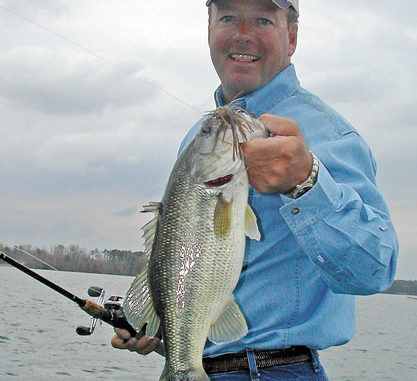
If there’s one thing I’d like to get across to bass fishermen who are figuring out what to do in February, it would be this: don’t get caught up in the calendar.
February is a very iffy month, in my opinion. I’ve seen bass spawn on Lake Murray in February, and I’ve also seen ice in the coves in February. It can be from one extreme to the other, depending on the severity of the winter we’ve had and how early spring comes.
One thing for sure: whether it’s cold or warm, February is a good time to catch a big bass. March is the best, but I think February is a really good time to catch a trophy bass in South Carolina.
Whether the water temperature is in the 40s or the 60s, I like to fish a Buckeye mop jig. To me, it’s a big-fish bait, and if you fish it at a time when you have a good chance to catch a big fish, you’re putting yourself in the best position you can. I use a jig no matter whether it’s warm or cold; what changes is location and the way I fish it.
If it’s cold, I fish closer to the main lake or the main river channel. I might be sitting in 10 to 20 feet of water, casting up into three feet. I think these fish tend to migrate and move toward the shallows even though the water is cold. I think they start their migration based on the changing length of daylight hours.
When it’s cold, I fish that jig slowly. People sometimes forget that bass are cold-blooded animals, and when the water’s cold, they’re slow. I fish it like you’d fish a Carolina rig. I just drag it along the bottom, slowly. If the water is warmer, I’ll give it some more action, more erratic action.
I typically use the same trailer, a Yamamoto Flappin Hawg. I’ll use the bigger one in colder water, because it gives the bait a little bigger profile. Obviously, bass think a jig is a crawfish. I’ve heard explanations on why big female bass like to eat crawfish during the prespawn, and some of the make sense. A crawfish is full or protein, and it’s a big meal — sort of like eating a chocolate milkshake before a game.
As far as colors are concerned, I like brown an awful lot. You can use a brown mop jig and put on a bright chartreuse trailer, or a green pumpkin trailer, and you can cover almost any water-clarity situation. If the water’s extremely dirty, you can go to a black, black/blue or purple.
The size of the jig I use depends on the depth I’m fishing and the wind. We can get lots of wind in February, especially toward the end of the month. It’s real important to be able to keep that jig in contact with the bottom and the cover and feel it all the time. When the water temperature is in the 40s, I’ll go with a half- or 5/8ths-ounce jig. When it’s warmer, I’ll typically go with a 3/8ths-ounce model.
One thing that some people have trouble with when they’re fishing a jig is they can’t feel the bottom. You’ve got to be able to feel everything your jig comes in contact with, so make sure you use a jig that’s big enough.
Typically, I’ll fish a smaller jig in warmer water because I’m fishing shallower, and because you’ve got a better chance of getting a bigger jig hung up. If you’re getting hung up a lot, drop down in size. If you’re feeling the bottom but you’re getting hung up, lighten up to a 3/8ths-ounce jig. If you keep getting hung up, change the kind of line you’re using, maybe go to a superbraid from mono. You’ll get so much better feel, and that can keep you from hanging up.
Fishermen should experiment with their lines. Buy a small spool of monofilament like Trilene XT or Berkley Big Game, then buy a small spool of braid like Fireline or Spiderwire. Make a few casts with the same bait and you’ll feel the difference. You can tell the difference at different depths.
One other thing about fishing a jig in February. So many people don’t want to jerk unless they know there’s a fish there. In February, fish really just inhale a jig and sit there. You almost don’t feel the initial strike; you just feel heaviness on the line. I think, if you feel something that feels different, you should set the hook. If there’s no fish there, you’ll know better the next time. And if there’s a fish there, it could be one of the biggest you ever catch.
Davy Hite, a 45-year-old native of Saluda who lives in Ninety Six, was BASS Angler of the Year in 1997 and 2002, and he has won the 1999 Bassmasters Classic and the 1998 FLW Tour Championship. He is sponsored by Triton boats, Evinrude outboards, All-Star rods, Pfleuger reels, Berkley Trilene, Yamamoto Baits, Owner hooks, Advance Land and Timber, Humminbird depthfinders and Solar Bat sunglasses.




Be the first to comment